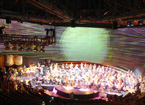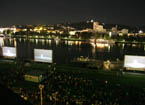| |
|
|
|
|
||
|
||||||||||||||||||||
|
|

ApproachA s a lab-atelier, the Ars Electronica Futurelab works
out approaches in the field of media performances by means of which the musical
works are linked up to computer-supported means of artistic expression to engender
new performance practices for stage productions. Working out visual modes of
interpretation for music, song and dance leads to an expansion of the classical
concept of artistic genres and, in turn, to the formulation of innovative
artforms whose specific characteristics manifest themselves in how the work
is produced and performed and how the audience partakes of it. On the basis of the development of tools of artistic representation utilizing media technology, the levels of perception of a work are successively expanded and synthesized to an experience that cannot simply be reduced to the individual elements that constituted the work’s point of departure. Each process of arranging an interactive visualization represents an individualized approach to a piece of material’s specific narrative structure, aesthetic claims and cultural-historical context. In addition to adaptations of classical compositions and existing stage productions, these efforts have also included the creation of original works that raise interesting issues with respect to the transformations of the dramaturgical components of the conventional elements of a work. ExperienceE ach one of a whole series of projects—“Apparition”,
“Das Rheingold Visionized”,
“Vision Mahler: Live Visualization of Mahler’s 2nd Symphony”,
“Le Sacre du Printemps: An Interactive Music, Dance and 3D Project”
and the visualization of a part of a Chinese Kunqu opera (Peony Pavillion,
Interrupted Dream) currently running at the eArt Festival in Shanghai -
showcases the specific forms of articulation of innovative works of art.A pparition
emerged in 2004 from intensive collaboration among leading
developers of creative technologies and experienced producers of works of
drama and dance. This was a one-of-a-kind effort to utilize sensor & tracking
technology to enable dancers to intensify the effect of the use of their bodies
in interaction with a visual and musical environment, whereby the levels of
perception of a traditional dance performance are synaesthetically expanded.
In another 2004 production, the Ars Electronica Futurelab worked together
with Linz’s Brucknerhaus on a means of enabling an audience to partake of
classical works in an extraordinary new way.

 T he interactive visualizations of Das Rheingold Visionized
were produced by means of stereoscopic projections in which the walls of
the concert hall were opened up to a seemingly infinite panorama of forms
and colors; the computer-controlled scenery follows Wagner’s work and reflects
the musicians’ interpretations in the form of dynamic structures that embody
the opera’s characters and scenes. The original score as well as psychological
and historical considerations went into the development of the figures and
determine the behavior of the individual visual elements. This was then
implemented into a computer code. What this entailed was imparting to the
computer the capacity to “hear” music and to modulate signals in accordance
with aesthetic criteria. 

 T his technique was developed further in 2005 in
Vision Mahler
, the 3D visualization of Mahler’s Resurrection Symphony. The amalgamation
of a virtual environment and a tonal space simultaneously in a real venue
(Cologne’s Philharmonic Hall) and on television (German channel WDR) was the
direct outcome of various technological developments in the areas of audio
analysis, 3D graphics and the virtual camera as well as comprehensive musical
analyses leading to the visual dramaturgy. Audio signals interpreted in real
time influence both the individual elements as well as the overall staging.

 T he 2006 adaptation of Stravinsky’s
Le Sacre du Printemps
created a 3D space coupled to musical impulses in combination with the
expressive means of the dance. The project bundled the experiences and
developments of the efforts that had preceded it and thereby generated a
complex network that continuously expanded the repertoire of computer-aided
means of expression. It took the next step in the process of elaborating
novel art forms via emergence effects at the interface of different genres.

 S uch cross-medial projects represent an amalgamation
of not only technologies and artistic genres, but also personalities and ways
of approaching a work, which gives rise to new methods of cooperation.
|
| © Ars Electronica Linz GmbH, info@aec.at | ||||||||||